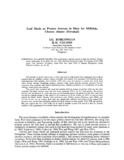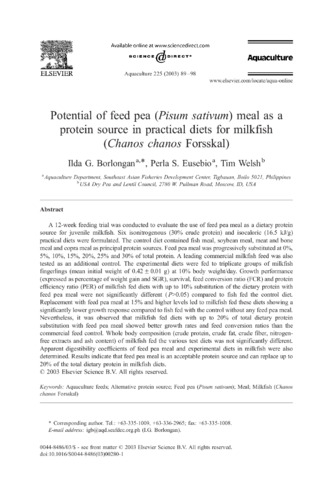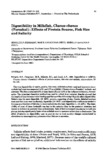Evaluation of various leguminous seeds as protein sources for milkfish, Chanos chanos Forsskal, juveniles
Share
| dc.contributor.author | de la Peña, Leobert D. | |
| dc.contributor.author | Chiu, Yvonne N. | |
| dc.contributor.author | Ganchero, Fe | |
| dc.coverage.spatial | Philippines | en |
| dc.date.accessioned | 2024-01-12T06:45:41Z | |
| dc.date.available | 2024-01-12T06:45:41Z | |
| dc.date.issued | 1987 | |
| dc.identifier.issn | 0116-6514 | |
| dc.identifier.uri | http://hdl.handle.net/10862/6513 | |
| dc.description.abstract | The nutritive value of four leguminous plant seeds: pigeonpea (Cajanus cajan), mungo (Phaseolus radiatus), kidneybean (Phaseolus vulgaris) and soybean (Glycine max), were evaluated as protein sources for milkfish (Chanos chanos) juveniles in isonitrogenous and isocaloric diets containing 40% protein. The legumes were heat-treated and added at different levels so that their protein contributed 25% of total dietary protein; peruvian fishmeal supplied the remaining portion. A diet with all protein contributed by fishmeal was used as a control. Substitution of 25% of the total 40% animal protein in the control diet by mungo and soybean meal did not adversely affect (P > 0.05) fish growth and the efficiency of feed conversion. Diets with 25% of protein contributed by pigeonpea and kidneybean meal resulted in significantly depressed (P ≤ 0.05) growth and efficiency of feed conversion. Milkfish survival rate was more than 97% throughout the six-week experimental period. We conclude that mungo and soybean meal, contributing at least 25% of dietary protein, can be used to replace fishmeal to reduce the cost of feed without adverse effect on the growth, survival and efficiency of feed conversion of juvenile milkfish. | en |
| dc.description.sponsorship | This study was funded by the NSTA PD 84-05. | en |
| dc.language.iso | en | en |
| dc.publisher | Asian Fisheries Society | en |
| dc.relation.uri | https://www.asianfisheriessociety.org/publication/downloadfile.php?id=674&file=Y0dSbUx6QXhORFl4T0RZd01ERXpOVFl4TkRjd05qTXVjR1Jt | en |
| dc.subject | Chanos chanos | en |
| dc.subject | Phaseolus vulgaris | en |
| dc.subject | Cajanus cajan | en |
| dc.subject | Glycine max | en |
| dc.subject | Philippines | en |
| dc.title | Evaluation of various leguminous seeds as protein sources for milkfish, Chanos chanos Forsskal, juveniles | en |
| dc.type | Article | en |
| dc.citation.volume | 1 | en |
| dc.citation.issue | 1 | en |
| dc.citation.spage | 19 | en |
| dc.citation.epage | 25 | en |
| dc.citation.journalTitle | Asian Fisheries Science | en |
| dc.subject.asfa | artificial feeding | en |
| dc.subject.asfa | diet | en |
| dc.subject.asfa | feed conversion efficiency | en |
| dc.subject.asfa | juveniles | en |
| dc.subject.asfa | protein sources | en |
| dc.subject.asfa | growth | en |
| dc.subject.asfa | survival | en |
| dc.subject.asfa | milkfish culture | en |
| dc.subject.asfa | fishmeal | en |
| dc.identifier.essn | 2073-3720 | |
| dc.identifier.doi | 10.33997/j.afs.1987.1.1.002 | |
| dc.subject.scientificName | Chanos chanos | en |
| dc.subject.scientificName | Phaseolus vulgaris | en |
| dc.subject.scientificName | Cajanus cajan | en |
| dc.subject.scientificName | Glycine max | en |
| dc.subject.scientificName | Phaseolus radiatus | en |
| local.subject | various leguminous seeds | en |
| local.subject | protein sources for milkfish | en |
| local.subject | Chanos chanos | en |
| local.subject | juveniles | en |
Files in this item
| Files | Size | Format | View |
|---|
This item appears in the following Collection(s)
-
AQD Journal Articles [1215]
These papers were contributed by AQD staff to various national and international journals



